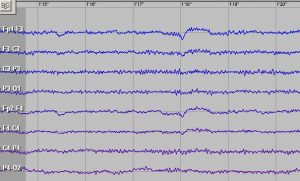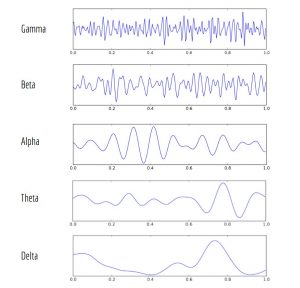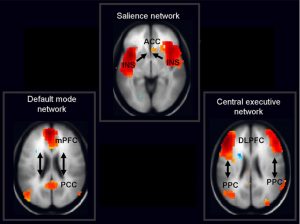MADELEINE YU | ONLINE REPORTER | SQ ONLINE 17-18
We’ve all been there: one minute, you are completely absorbed in lecture and then the next minute, you’re wondering if you have all of the ingredients at home to make that one really tasty-looking stew that appeared on your Facebook feed, and oh yeah, did you remember to turn off the stove this morning?
Throughout your day, your brain switches from focusing all of your attention towards the tasks at hand to delving so deep into your internal thoughts that you lose track of time and place. This occurrence is not only reflected in your actions, but in the activity of your brain waves as well.

Brain waves, also referred to as neural oscillations, is used to describe the rhythmic electrical activity of the central nervous system. The existence of brain waves was first discovered in 1924 by Hans Berger through an early form of electroencephalography (EEG). Neurons not only fire independently, but collections of neurons, deemed “neural ensembles”, fire in a synchronized fashion. Interestingly, these neurons do not need to be close in location either to fire collectively.
So, why does this happen?
Unfortunately, the jury is still out. Researchers postulate that the waves, and the locations in which they synchronize, could be reflective of the brain’s information processing. Even more evidence supports their role in other cognitive functions, such as perception, motor control, memory, and even in sleep and consciousness.
The Brain Wave Investigation
There are five main frequencies at which neurons fire: gamma (30-150 Hz), beta (13-30 Hz), alpha (7.5-12.5 Hz), theta (4-8 Hz), and delta (1-4 Hz). While the presence of each is not well-defined in terms of how they relate to behavior, researchers are trying to determine their functions through the cases in which activity is atypical.

In 2015, a team of researchers from the Stanford University School of Medicine examined the brains of 180 children using functional magnetic resonance imaging (fMRI), with half of the children diagnosed with attention deficit hyperactivity disorder (ADHD) and the other half without. The team found that in typically developing children, there were highly coordinated interactions between three neural networks of the brain. The first is the salience network, which pertains to brain areas such as the anterior insula and the anterior cingulate cortex, and is active during the online selection of important information out of external stimuli. Secondly, the default mode network features another set of brain regions that become active during introspective activities such as daydreaming. Third, the central executive network works while information is manipulated and held in working memory. In tasks where the children focused their attention, those not diagnosed with ADHD demonstrated a salience network that lowered the neural activity within the default mode network and raised that of the central executive network. Meanwhile, children with the attentional disorder showed weaker interactions between the three networks. Furthermore, the difference between the groups was great enough that the researchers could distinguish those diagnosed with ADHD from those who were not.

The role of these three neural ensembles’ interactions even extend further to include correlated deficits in association with those with brain injuries, depression, schizophrenia, autism, and drug addiction.
Research at UC San Diego
Researchers at UC San Diego have joined the investigation of neural oscillation synchrony. Dr. Bradley Voytek, a prominent figure in cognitive science research, works with his lab to study the role of neural oscillations and neural noise as they impact cognition, aging and disease. Past research by Voytek and his lab has included taking a look at how alpha oscillations alter through age. Typically involved in attention towards environmental cues, alpha wave phases appear to be less consistent in older adults of 60-70 years of age. This finding supports that changes in alpha phase dynamics potentially contribute to the onset of cognitive decline as we age.
More recently, the lab examined the role of beta waves in the motor cortices of those with Parkinson’s. The team noticed the oscillations were unusually sharp and asymmetric in comparison to typically observed beta waveforms. The researchers took this even further by using deep brain stimulation to reshape the waves, which contributed to the reduction of Parkinson’s Disease-related motor symptoms.
Another prominent UC San Diego researcher is Dr. Jaime Pineda, who works with his lab to find ways for children with autism to modulate their own brain waves. Through prior research, Pineda and colleagues discovered that a specific alpha waveform found specifically in the motor cortex, the mu rhythm, reflects observed biological motion by others and perhaps impacts empathic abilities. Significantly, the characteristic suppression of this waveform appears to be absent in those with autism. As a result, Pineda and his lab utilize neurofeedback training, a method through which participants play a video game that requires the modulation of mu rhythms to complete a task. In one study, 19 high-functioning children diagnosed with autism spectrum disorder underwent training and subsequently demonstrated a marked normalization of mu rhythm suppression and showed improvements in sustained attention. Today, the lab is currently examining the effects of neurofeedback training in those diagnosed with schizophrenia.
Furthermore, UC San Diego researcher and professor, Dr. Andrea Chiba, is the co-director of the Temporal Dynamics of Learning Center whose aim is to understand the role of timing within the brain and how it relates to greater learning. In some studies, Chiba and colleagues specifically examined the neurochemical influences on neuronal ability to respond to the sensory world in synchrony. While primarily working with mice, the researchers stimulated the production of specific neurotransmitters that directly influenced the firing rate of neurons and affected the encoding capacity of certain neural networks. In the case of acetylcholine stimulation in the visual cortex, greater intake of external information was observed. Such research can be understandably translated to the classroom where students need to parse out the relevant information from the irrelevant, and it may be the case that attentional abilities could be effectively modulated provided the specific players involved are identified.
Such work by these researchers not only provide useful insights into the neurophysiological implications of typical and atypical cognitive abilities, but also offers practical and hopeful new avenues for those struggling to function day to day. What’s more is that this research is live and ongoing, and happening everyday, right here at UC San Diego.
[hr gap=””]
Resources
- https://www.flickr.com/photos/bwjones/35430889342
- https://commons.wikimedia.org/wiki/File:BetaWojder.jpg
- https://commons.wikimedia.org/wiki/File:Fnbeh-08-00171-g002.jpg
- https://med.stanford.edu/news/all-news/2015/12/attention-networks-different-in-kids-with-adhd.html
- https://www.ncbi.nlm.nih.gov/pmc/articles/PMC2899886/
- https://www.nature.com/articles/srep21353
- http://www.iapsych.com/articles/bressler2010.pdf
- http://voyteklab.com/about-us/
- http://voyteklab.com/wp-content/uploads/Tran-NeuroImage2016.pdf
- http://voyteklab.com/wp-content/uploads/Cole-JNeurosci2017.pdf
- http://bci.ucsd.edu/Staff.html
- https://en.wikipedia.org/wiki/Mu_wave
- http://bci.ucsd.edu/Papers_files/Positive%20behavioral%20and%20electrophysiological%20changes%20following%20neurofeedback%20training%20in%20children%20with%20autism_2.pdf
- http://tdlc.ucsd.edu/about/about.html
- http://www.pnas.org/content/114/22/5725